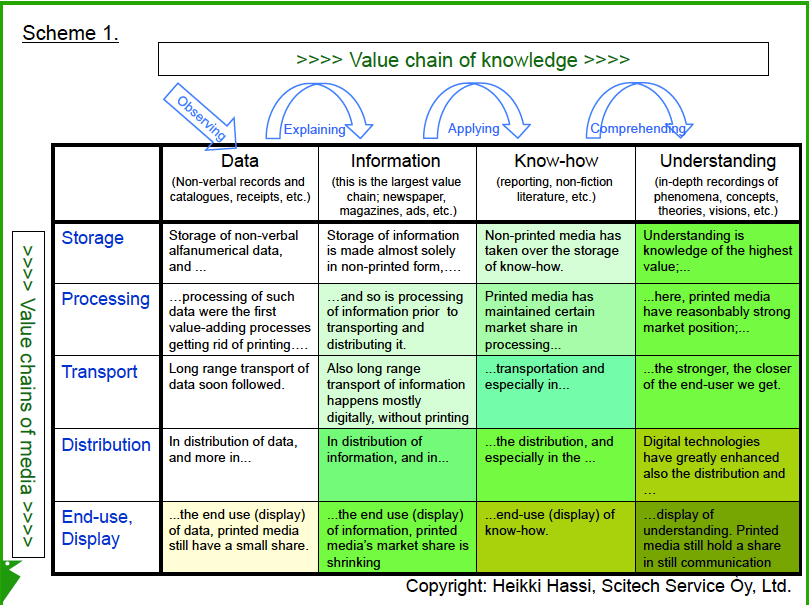That the kingdom of media and communication is ruled by the digital is no news. Some 20 years ago it wasn’t news, yet, but a future vision. How and why did this revolution happen?
To analyze this, it’s more useful to divide media into printed and non-printed categories, rather than into printed and digital. This is because the value chains of printed media were first digitalized – and gained hugely from that – and only later were they gradually taken over by the non-printed digital media.
The progress of this revolution is illustrated in Scheme 1, where columns represent value-adding chains of media, proceeding from feed stock storage to final end-use – the reception of delivered knowledge by a human consumer. The field of knowledge, again, is divided into four segments; from the lowest value knowledge (data) to that of the highest value (understanding). In the case of understanding, absorption, rather that mere reception may be a more proper term for the end-user’s role.

Digital technology reduced the need of printing first in the upper-left corner of the matrix, i.e, in the beginning of media’s value chain and when data, the simplest form of knowledge was handled. This started to happen already in the 1970’s, when, e.g., first digital cash registers and inventory systems were launched. (In Finland it was done by Nokia, when the company was still also making rubber boots and sneakers.). However, here the user interface is still usually a printed receipt.
Gradually, as digital technologies developed, non-printed media started taking over all four value chains presented in Scheme 1. Today, the market share of printed media is the highest in the lower right corner of Scheme 1., i.e., closest to the consumer and when the highest value of knowledge, namely understanding is to be conveyed to her or him. This is because successful absorption of understanding is more about the performance of the human end-user than about the efficiency of the delivery chain or the versatility of the display. There, printed pages often work better than an electronic, digital display.
A main driver of this development, apart from the greatly enhanced performance which digitalization brought to media, was cost reduction – thanks to dematerialization of the value chain operations. Dramatically improved performance combined with dramatically lower cost caused the actual revolution in media – namely that of exploding volume (as measured in bits or unprinted pages). Finnish writer and politician Osmo Soininvaara – also a statistician – recently pointed out that if all the digital photographs taken today were taken and developed using the old chemical film and paper technology, the photography business would represent a rather large part of our GDP.
As printed medias’ markets have been limited to still media – those not able to show movement or generate sound, this is also where the limits of my rather straightforward analysis are. Talking movies are a different matter. So is direct (unedited and, originally mostly vocal) distant communication; another field where digitalization brought about a revolution; tremendous growth and diversification.
The importance of high performance, low-cost and convenient display technology to the revolution in media and communication is manifested by the fact that such displays have not only substituted much of the printed media as an end-user interface, but also caused a shift form vocal to visual even in prompt bilateral telecommunication.
Scitech’s business is, and its strengths are in the value chain showed on the top of Scheme 1.; that of adding value to knowledge: Explaining data to gain information; applying information to generate know-how, and bringing about understanding by helping our customers to comprehend complex processes of biomass conversion – industrial ones as well as those still running in laboratory only. That topic deserves another blog text.
Nevertheless, the above discussion helps to explain why the future in cellulose fiber consumption clearly lies in structured products such as packaging, tissue and regenerated cellulose (textiles) and why printed media will still decline.